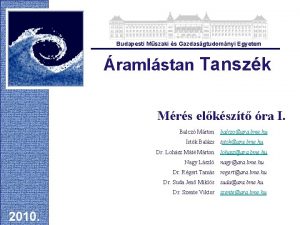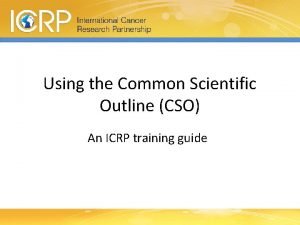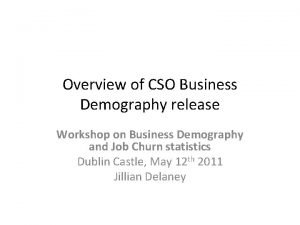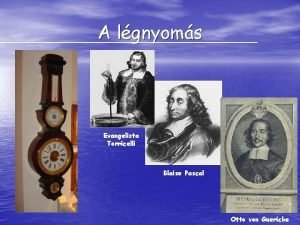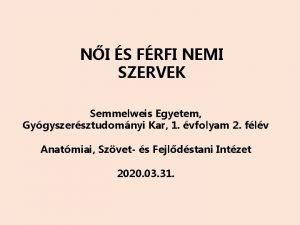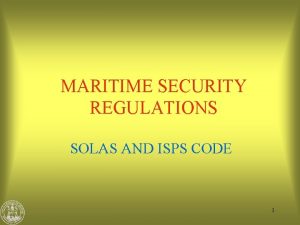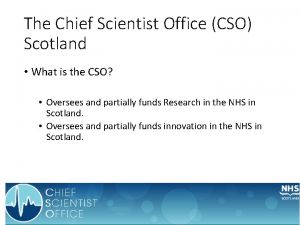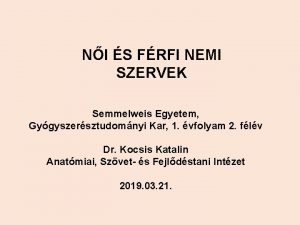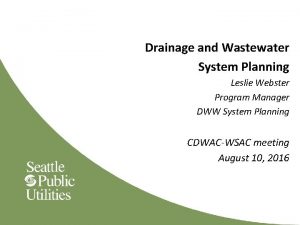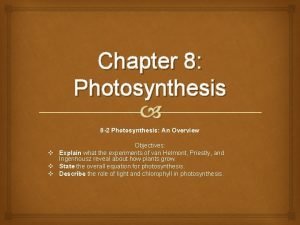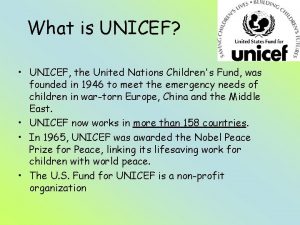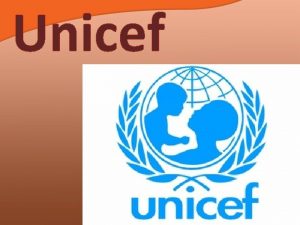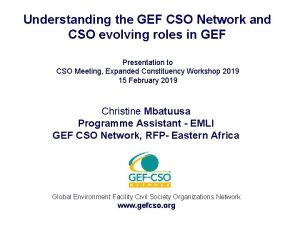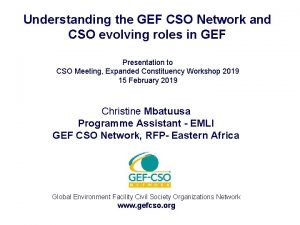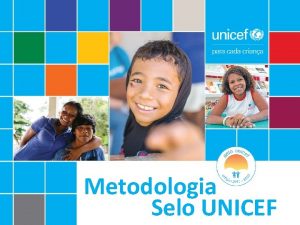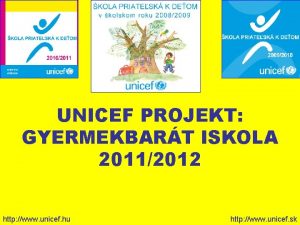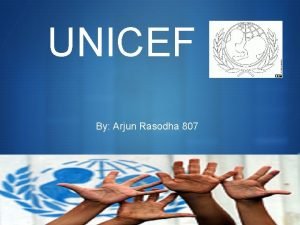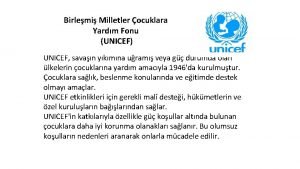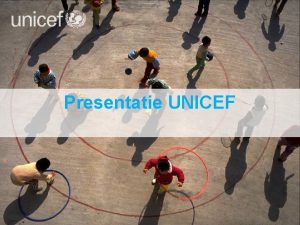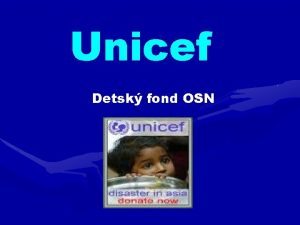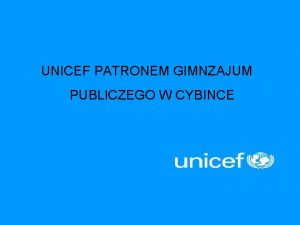UNICEF CSO Procedure Overview of key changes March
















- Slides: 16

UNICEF CSO Procedure Overview of key changes, March 2015

Overview q q Supersedes 2009 PCAs and SSFAs Guidelines (CF/EXD/2009 -011) Transition period from 01 April – 01 June 2015 § Offices can adopt as early as 01 April but MUST adopt by 01 June q q For use by Country & Regional Offices All agreements entered into prior to effective date remain valid § Any new agreement/ amendments – except no cost extensions - follow new Procedure

New agreements q PCA “umbrella” agreement to cover duration of the country programme § Details of the partnership defined in accompanying programme document(s) – results, work plan, budget q SSFA limit raised to $50 K § Can be used in humanitarian response also for transfer of 3 months supplies Not included Mo. U – where there is no transfer of resources

Clarifies Partnership vs Procurement Partnership UNICEF defines scope of work & results to be achieved. CSO identified through competitive bidding process § Institutional contract or § Long-Term Arrangement for Services (LTAS) UNICEF and the CSO pool together resources to achieve commonly defined results, sharing costs and benefits § Programme Cooperation Agreement (PCA) or § Small-Scale Funding Agreement (SSFA) No set amount for contribution but a key requirement for partnership If major components of programmes to be subcontracted, other options should be considered These modalities can be used concurrently with the same CSO

Requires documentation of CSO selection Open selection Direct selection § UNICEF office issues a call for expression of interest § UNICEF office partners with a CSO for a specific proposal – Transparent process – Supports identification of new partners/ approaches – May require more time – Responsive to specific considerations, such as known expertise, timing/ criticality of intervention, innovation… – Limits transparency/ cost effectiveness analysis

Clarifies due diligence process • Done by HQ for ICSO • By COs for other CSO based on Partner Declaration & check of UN sanctions list Ability to deliver programme results part of CSO selection process Type of agreement Core values HACT/ Micro assessment Programme assessment PCA with regular, contingency or humanitarian) Mandatory before partnership If CSO expected to CO receive $100 K or discretion more/ year. To be done before or after PCA onset CO discretion when partnership <$100/year (before or after PCA onset) SSFA Mandatory before partnership Not required CO discretion Simplified financial asses.

Simplified programme document q q Reduced narrative Results-based workplan & budget in the same table Budget defined at activity – not input level Includes planned assurance activities & partnership review dates

Simplified programme document/ humanitarian response Programme Document Regular programme or emergency response Simplified Humanitarian Doc First 3 months of humanitarian response or L 2/L 3 emergencies 1. Programme info & CSO overview Basic Very basic 2. Programme description Brief but complete programme rationale & expected results Simplified humanitarian data & targets for the response 3. Workplan & budget Results, performance indicators activities, timeframe & budget Simplified activity based budget with 1 line for ops&mngt costs 4. Partnership review plan Complete plan of reviews with UNICEF Status of assessments & risk management measures (if any) 5. Other Additional reporting & technical guidance N/A Signatures & date Yes Key features

Revised budgeting & detailed guidance q Programme costs include a standard output & activities for Effective & Efficient Progr. Management § Replace DPSC and the associated 25% cap q HQ Support Costs same rate (7% of cash component) § payable to INGOs upon reporting actual expenditures – not as advance § Payment to national CSOs at Rep. discretion § Not applicable to SSFAs Detailed guidance on budgeting, eligible expenses & other fin. / admin. issues (currency, bank account, VAT. . )

Streamlined Partnership Review Committee q q q Guidance on membership & PRC Submission Form Flexibility to fit the office/country context Benchmark of 45 days to operationalize partnership in regular programme; 20 days for initial disbursement of donor funds in humanitarian action

New guidance on partnership management Annual Partnership Review meeting if partnership >$100 K PCA/Programme document revisions guidance New benchmark of 10 working days for disbursing funds following submission of properly filled FACE form (accompanied by itemized cost estimate – ICE)

Streamlined reporting Simple template for quarterly reporting on results aligned to reporting with FACE – no additional report required Additional reporting requirements to be agreed upfront in progr. doc (e. g. monthly reporting in humanitarian situations)

Options for onset of humanitarian response Type of partnership Ongoing partnership New partnership Programme instruments for rapid response Approval Contingency PCA/ prog. doc Rep. Simplified humanitarian progr. doc Rep. Revision of existing progr. doc Rep. PCA + Simplified humanitarian progr. doc Rep. SSFA Rep. New role of SSFA to transfer up to 3 months of supplies for immediate distribution

In summary – CSO Procedure Overview IDENTIFYING CSO CONCLUDING § Activity closure & performance review § Termination of programme document/ partnership IMPLEMENTATION, MONITORING, REPORTING § Assurance activities integrated in the Prg. Doc as per HACT § Financial & programmatic quarterly reporting with FACE § Annual Partnership Review meeting § Guidance for revisions & PCA amendment form STEP 4 Concluding, Suspension or Termination STEP 1 § Procurement vs Partnership: decision tree & list of services § CSO selection § Core values ICSOs – done by HQ based on Partner Declaration Identifying CSO STEP 3 Implementation, Monitoring & Reporting STEP 2 Designing & Formalising Relationships DESIGNING & FORMALISING RELATIONSHIP § PCA “umbrella” legal agreement covering CP or grant duration § SSFA for transfers <$50, 000 & 3 months supplies in emergency § New Programme doc. Template & Simplified emergency doc § Guidance on Budgetary issues

Roll-out activities (staff & CSO) Key 2015 activities Training material/tools 2 pager Overview of key changes for partners & staff 2 pager Overview of CSO Procedure Partner version of the CSO Procedure Training materials (presentation, website, intranet) Working with CSO e-course for staff & partners Capacity building events Dedicated CSO roll-out/TOT trainings Series of webinars Mar-Apr. & on request Orientation on new Procedure mainstreamed in key regional events Feb. onwards entry point for training of CSO partners at regional level Q 2 Q 3 Q 4

Thank you for your inputs § Global Results Network members § HQ divisions, especially EMOPS § CSO community Individual country Thank you foroffices your inputs § § WASH specialist
 Anthem of poland
Anthem of poland Changes in latitudes, changes in attitudes meaning
Changes in latitudes, changes in attitudes meaning Changes in matter
Changes in matter Ferdecsöves manométer
Ferdecsöves manométer Cso codes
Cso codes Cso business demography
Cso business demography Torricelli cső
Torricelli cső Gl. bulbourethralis
Gl. bulbourethralis Functional requirements of isps code
Functional requirements of isps code Chief scientist scotland
Chief scientist scotland Gl bulbourethralis
Gl bulbourethralis Cso seattle
Cso seattle Key partners key activities key resources
Key partners key activities key resources Key partners
Key partners Section 8-2 photosynthesis an overview answers
Section 8-2 photosynthesis an overview answers Chapter 17 elements and their properties answer key
Chapter 17 elements and their properties answer key What is unicef
What is unicef



